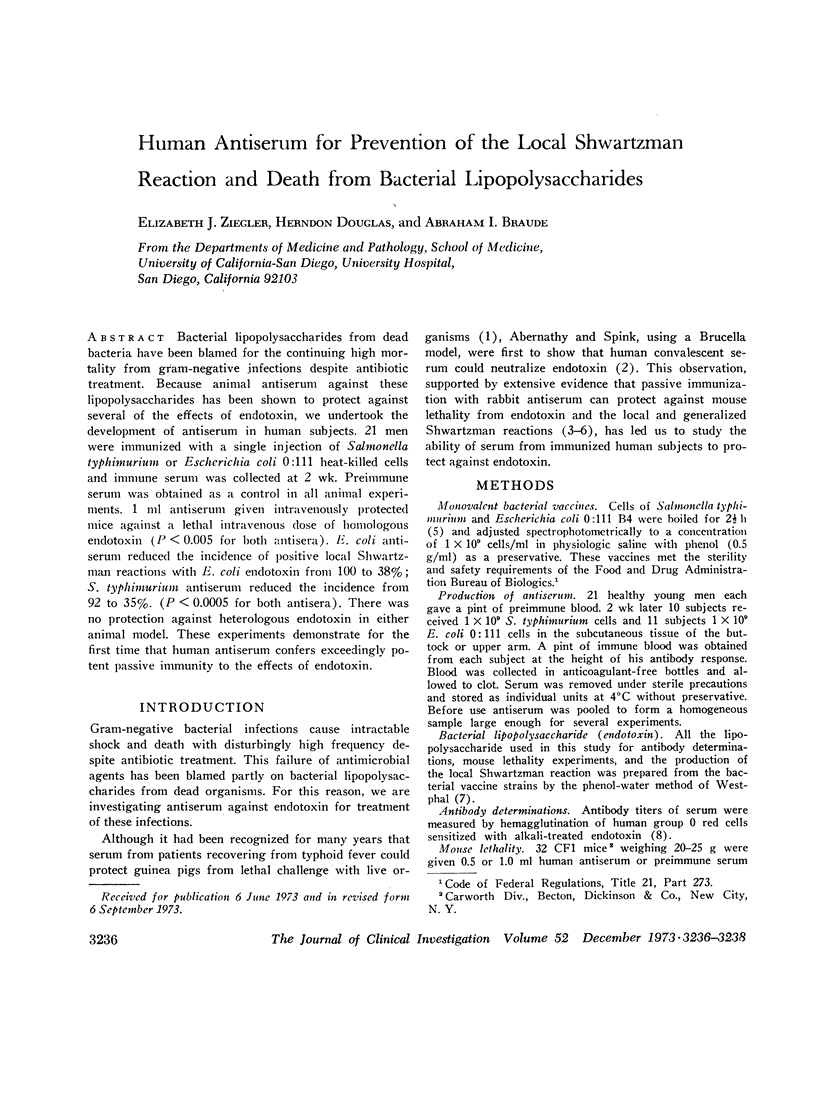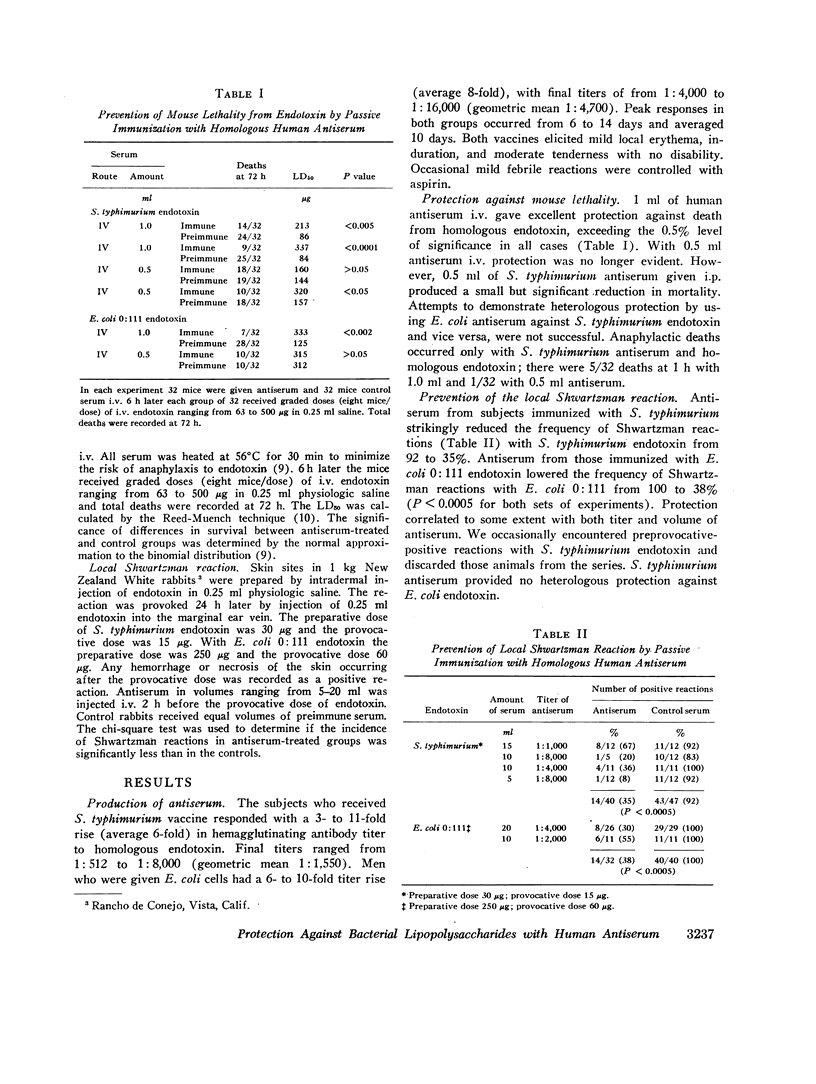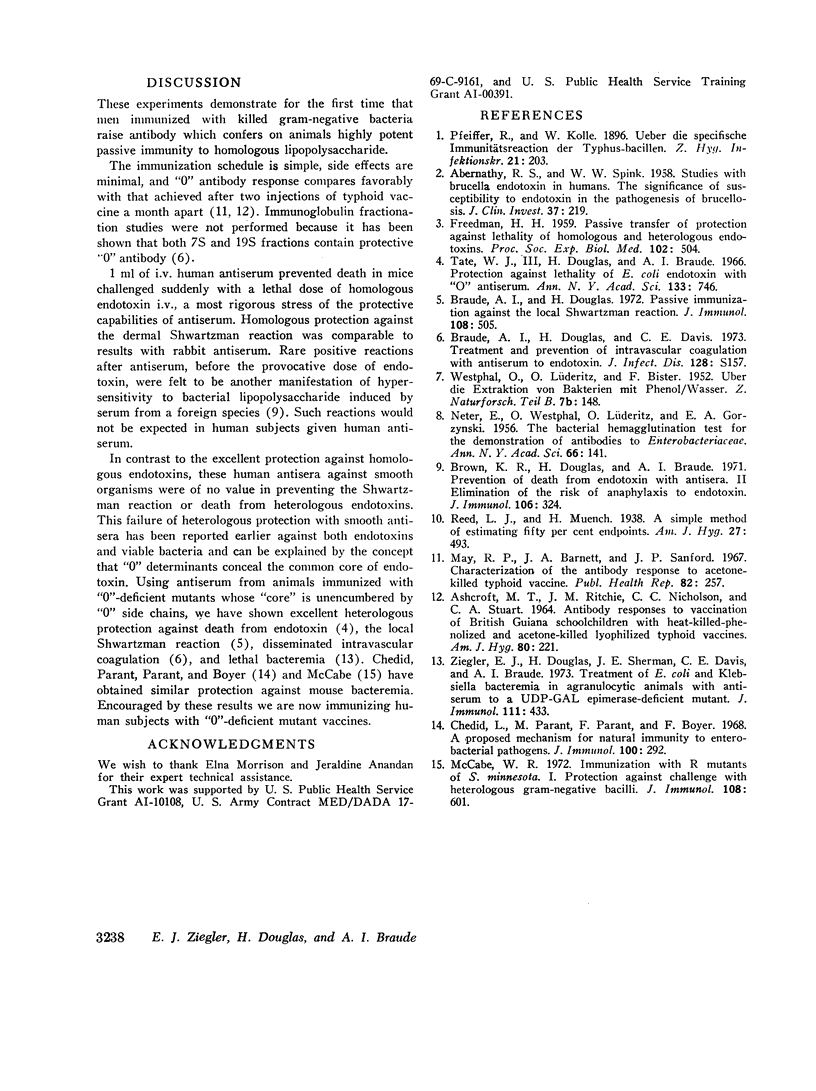Abstract
Bacterial lipopolysaccharides from dead bacteria have been blamed for the continuing high mortality from gram-negative infections despite antibiotic treatment. Because animal antiserum against these lipopolysaccharides has been shown to protect against several of the effects of endotoxin, we undertook the development of antiserum in human subjects. 21 men were immunized with a single injection of Salmonclla typhimurium or Escherichia coli 0:111 heat-killed cells and immune serum was collected at 2 wk. Preimmune serum was obtained as a control in all animal experiments. 1 ml antiserum given intravenously protected mice against a lethal intravenous dose of homologous endotoxin (P < 0.005 for both antisera). E. coli antiserum reduced the incidence of positive local Shwartzman reactions with E. coli endotoxin from 100 to 38%; S. typhimurium antiserum reduced the incidence from 92 to 35%. (P < 0.0005 for both antisera). There was no protection against heterologous endotoxin in either animal model. These experiments demonstrate for the first time that human antiserum confers exceedingly potent passive immunity to the effects of endotoxin.
Full text
PDF


Selected References
These references are in PubMed. This may not be the complete list of references from this article.
- ABERNATHY R. S., SPINK W. W. Studies with Brucella endotoxin in humans: the significance of susceptibility to endotoxin in the pathogenesis of brucellosis. J Clin Invest. 1958 Feb;37(2):219–231. doi: 10.1172/JCI103601. [DOI] [PMC free article] [PubMed] [Google Scholar]
- ASHCROFT M. T., RITCHIE J. M., NICHOLSON C. C., STUART C. A. ANTIBODY RESPONSES TO VACCINATION OF BRITISH GUIANA SCHOOLCHILDREN WITH HEART-KILLED-PHENOLIZED AND ACETONE-KILLED LYOPHILIZED TYPHOID VACCINES. Am J Hyg. 1964 Sep;80:221–228. doi: 10.1093/oxfordjournals.aje.a120470. [DOI] [PubMed] [Google Scholar]
- Braude A. I., Douglas H. Passive immunization against the local Shwartzman reaction. J Immunol. 1972 Feb;108(2):505–512. [PubMed] [Google Scholar]
- Brown K. R., Douglas H., Braude A. I. Prevention of death from endotoxin with antisera. II. Elimination of the risk of anaphylaxis to endotoxin. J Immunol. 1971 Feb;106(2):324–333. [PubMed] [Google Scholar]
- Chedid L., Parant M., Parant F., Boyer F. A proposed mechanism for natural immunity to enterobacterial pathogens. J Immunol. 1968 Feb;100(2):292–306. [PubMed] [Google Scholar]
- FREEDMAN H. H. Passive transfer of protection against lethality of homologous heterologous endotoxins. Proc Soc Exp Biol Med. 1959 Nov;102:504–506. doi: 10.3181/00379727-102-25296. [DOI] [PubMed] [Google Scholar]
- GORZYNSKI E. A., LUDERITZ O., NETER E., WESTPHAL O. The bacterial hemagglutination test for the demonstration of antibodies to Enterobacteriaceae. Ann N Y Acad Sci. 1956 Aug 10;66(1):141–156. doi: 10.1111/j.1749-6632.1956.tb40113.x. [DOI] [PubMed] [Google Scholar]
- May R. P., Barnett J. A., Sanford J. P. Characterization of the antibody response to acetone-killed typhoid vaccine. Public Health Rep. 1967 Mar;82(3):257–260. [PMC free article] [PubMed] [Google Scholar]
- McCabe W. R. Immunization with R mutants of S. Minnesota. I. Protection against challenge with heterologous gram-negative bacilli. J Immunol. 1972 Mar;108(3):601–610. [PubMed] [Google Scholar]
- Tate W. J., 3rd, Douglas H., Braude A. I., Wells W. W. Protection against lethality of E. coli endotoxin with "O" antiserum. Ann N Y Acad Sci. 1966 Jun 30;133(2):746–762. doi: 10.1111/j.1749-6632.1966.tb52403.x. [DOI] [PubMed] [Google Scholar]
- Ziegler E. J., Douglas H., Sherman J. E., Davis C. E., Braude A. I. Treatment of E. coli and klebsiella bacteremia in agranulocytic animals with antiserum to a UDP-gal epimerase-deficient mutant. J Immunol. 1973 Aug;111(2):433–438. [PubMed] [Google Scholar]


